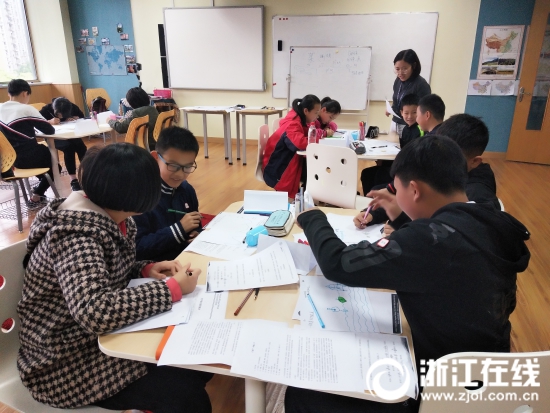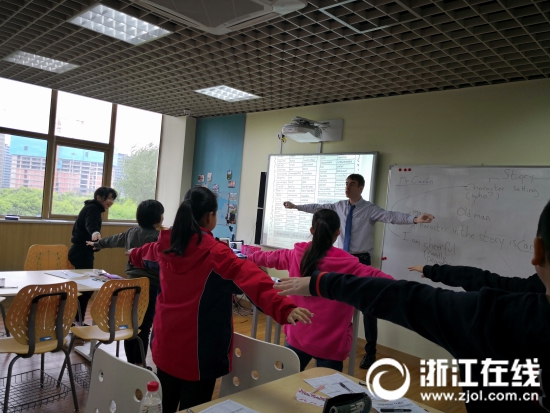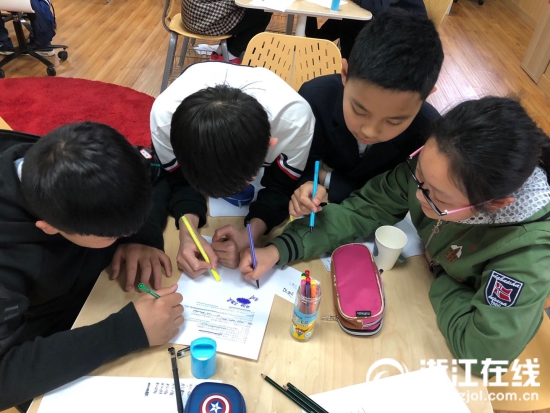Hangzhou Wahaha Bilingual School Junior High School Advantage Integration Course Experience Course Open

Zhejiang Online, April 20 (Zhejiang Online reporter, Zhu Geqian, intern, Sui Xue, correspondent, Zhang Ye)Recently, the Junior High School of Hangzhou Wahaha Bilingual School opened an integration course to parents. Sixth graders from each school experienced an experience class on cross-cultural integration of Chinese, English, science, and society and history.
Poetic Chinese Classroom – The Cultural Core of Chinese and Western Use
How does a Chinese fusion class that cannot see the traces of Western culture achieve cross-cultural integration? The teacher chose four West Lake poems by two writers with deep roots in Hangzhou, Bai Juyi and Su Dongpo, to start group classroom teaching.
After getting the materials, the teacher guided each group to complete the corresponding tasks according to the teaching goals – reading through the poems, understanding the poems with pictures, and recommending poems. After deepening their understanding of poems in the first two links, the students went on stage to report the results of the group’s study.
Giving the classroom to students and using the more autonomous group collaboration and team display classroom model in the West to learn Chinese classic poetry can be regarded as an innovation in Chinese teaching methods. "In terms of teaching content, we still adhere to the core position of Chinese culture, but in terms of Chinese teaching methods, we continue to try to adopt more student-centered Western teaching strategies," said the teaching teacher.

In the future, there will also be comparative reading of Chinese and Western literature and translation and appreciation of Chinese and English classics in the school’s language classes, strengthening comprehensive learning practices, so that students can experience the beauty of language learning in an independent, cooperative and open classroom.
Pure English classroom – an all-English immersion environment
What is a "story"? Foreign teacher Ciaran led the children to re-understand the "story" from the perspectives of characters, settings and plots in an hour and a half. The all-English class mode made many children a little restrained at first. But the humorous Ciaran teacher soon got to know the students well.
Starting from a simple discussion of Who, When and Where, What Happened, these easier-to-understand concepts, students understand the basic concept of "story" and the different forms of "story". By combining life scenes with previous reading experiences, students grasp the three basic elements of story: Character (character), Setting (setting), Plot (plot).
Afterwards, Teacher Ciaran prepared the Minions’ story fragment "Competition", using the short film as a material to analyze the different elements that make up the story in a more targeted manner and strengthen the study of theory. Finally, the group’s task list "AT THE MOVIES" was completed in a group collaboration. The students learned and analyzed the structure of the text through four aspects of listening, speaking, reading and writing, and returned to the study of English knowledge.
Rigorous Chemistry Classroom: A Comparative Study of Chinese and Western Teaching Concepts and Methods
The chemistry classroom fully reflects the rigorous spirit of the subject. The chemistry teacher compared the "Compulsory Education Textbook" (Zhejiang Education Press) and "Science Fusion" (a set of top science courses published by Houghton Mifflin Harcourt Group in the United States, which are used as science textbooks in many public schools in the United States). Combining the advantages of the two sets of textbooks, students are guided step by step to complete the teaching objectives of this class: to understand the physical and chemical properties of acids or bases, and to be able to judge the acid and alkali properties of substances according to the physical and chemical properties of acids or bases.
The rigorous classroom was also very interesting, and the students were very interested in the introduction of the teacher in the life situation, and the classroom atmosphere quickly became active. After a class, the students learned not only the chemistry knowledge required by the curriculum standard and the core English vocabulary involved in these knowledge.
"What’s even more exciting is that after the science class, some students came over and asked me for pH test strips because they wanted to go back and continue to study the acidity and alkalinity of more substances. This is what we want to train children to better understand the world through their own curiosity and their own perception through science class," said Liu Zhaoyun, a chemistry teacher.

Dialectical Society and History Classroom – Seeing the World from Multiple Perspectives
Around the two questions of "what is history" and "what are we studying in history", the society and history teacher also replaced the "Yiyan Hall" with the form of "discussion group", and asked each group of students to design a story according to the historical characters assigned. Students work in groups and choose a representative to speak. Other group members judge which plots are real and which are made up.
The teacher guides the students to express their opinions with questions and materials, and finds the key to the exit in the collision of viewpoints, which not only gives the students the opportunity to fully express themselves, but also leaves a vast space for thinking. At the same time, the teacher also tries to cooperate with the students to learn. When thinking about the ultimate question that human beings must face, "Where do I come from?", the students are pleasantly surprised to provide many philosophical answers.
Learning history is not only about learning about the development and changes of China and the world, but also about cultivating students to understand history philosophically and balance the relationship between themselves and the world. Specific to the junior high school stage, it is the cultivation of historical understanding and critical thinking.
In the end, each group was given three passages about Hitler’s teenage, adolescent and middle-aged experiences without his name, and asked to read them and summarize the character’s characteristics. Faced with these historical materials alone, the students felt the character’s loneliness, literature, pity and horror. "To understand and analyze the character from multiple angles rather than to make a coffin with a fixed concept is what we want to pass on to the student through the course. This is true for understanding a person, but even more so for understanding a culture and a concept," the instructor said.
If you accidentally miss this integration course experience, parents can also pay attention to participating in this Sunday’s integration course experience, so that your child can experience another cross-cultural journey brought by our school’s math, physics, English and physical education teachers.